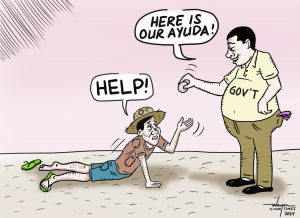 When one talks so much, along the way he or she is likely to get spewed. In the same vein there is this oft-repeated saying that when one sows a wind he/she is likely to reap a whirlwind. Or so it seems what is happening in the country these days.
When one talks so much, along the way he or she is likely to get spewed. In the same vein there is this oft-repeated saying that when one sows a wind he/she is likely to reap a whirlwind. Or so it seems what is happening in the country these days.
Nowadays there are brewing condemnations of something that happened in the country years back which the people know could not just be attributable to one person, a group or even to an organization or agency. But because there were earlier premises, those who felt aggrieved or have burning hatred against the person, the group or agency, everything is heaped on them instead.
Now let us see how far the condemnations can go and find out whether those who are initiating the condemnations have the legal even moral basis for their clearly political and self-assuming action.
**************************
We do not know how far the underground cabling project of Davao City and Davao Light and Power Co. (DLPC) can go. But so far the three major city streets that are showcased in the projects are like newly bathed and dressed persons after having gone through days of getting dumped in dirty drainage.
Yes, Magallanes St., Claveria or C.M. Recto St., and lately San Pedro St. are presently “apples to the eyes” of everyone passing through the said thoroughfares as the spaghetti wires and cables with some dangerously dangling on the side are already gone. Any pedestrian on the streets mentioned can now have a clear view of the heavens without their sights blocked by wires of electric and communications utility firms. Even the poles that used to stand on the sidewalks to support the wire installation are already gone. In other words, the underground cabling project of the city government and the power distribution firm is one respite for the weary eyes of people coming to the city proper for whatever purpose.
And soon, the first three streets are expected to be added with one more – the Ramon Magsaysay st. But all these city roads happen to be primary routes when one comes to the city’s central business district (CBD). There are other roads that are getting busier as more establishments are opting to locate in areas within the outskirts of the CBD necessitating the extension or installation of more power and communication lines above the ground. More importantly, the project partners may have to consider implementing the underground cabling project in roads where visitors to Davao City will most likely have their first impression of the city’s overall situation. Say, portions of MacArthur Highway, J.P. Laurel Highway, the whole of Quimpo Blvd., the airport road or R. Castillo st. from Lanang.
Of course, doing the underground cabling on the mentioned thoroughfares requires a humongous budget and will result in traffic bedlam creating more inconvenience to motorists and pedestrians. But once done the positive impact to the city will be immeasurable.
Of course, as we usually say in this space about projects, there will always be beneficiaries and sufferers. And if the number of beneficiaries far exceeds that of those who are likely sufferers, then people have to be ready to make sacrifices, big or small, if only to attain real development.
The next question is how much can the local government afford to cough out from its coffers to contribute to the financial requirement of the project without upward adjustment of its collectible taxes? And how deep can the electric utility push its hand to its pocket and draw its own resources to keep the underground cabling project going without recovering its investment from the consumers?
For now, there is no doubt the praises of the completed project and the ideal working relationship between the city government and its power firm partner are all positive and therefore extremely pleasant to the ears.
It is one relationship nee partnership that is very much unlike those of other electric utilities and the local government units they serve which are publicly chastised and even the service frowned upon.
Nonetheless, we know that the local power distribution company knows that no matter how big its financial outlay for the city’s underground cabling it can easily recoup when the project will be able to entice business investors to locate in Davao City where the power utility is seen not just as a business unit but as a corporate citizen as well. In other words, it is one corporate entity that is a partner in development.
That is why we are not surprised that nearby LGUs served by other power retailer firms are salivating to become the Davao City power retailer’s service area. After all these LGUs know that what it pays to the utility they can also get projects in return.
We can only hope that their wish will eventually be granted.

ROUGH CUTS| Partners in development
More from COLUMNMore posts in COLUMN »

